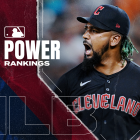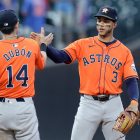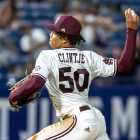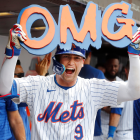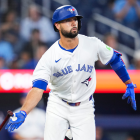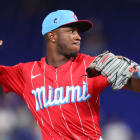Over the last few months, the Yankees have reversed course and become something many folks have never seen them be before: Sellers. The Bronx Bombers haven't had a losing season since 1992, and the last time they sold in any real form was 1989. That's the year they traded Rickey Henderson and Mike Pagliarulo at the deadline.
This year the Yankees traded four productive veterans for a bevy of prospects at the trade deadline. Aroldis Chapman, Andrew Miller, Carlos Beltran and Ivan Nova were moved. Miller is the one who shows the Yankees are serious about getting younger. He's signed affordably through 2018. They easily could have kept him. The other three were impending free agents.
New York's sell-off continued this week with the Brian McCann trade. McCann was traded to the Astros for two pitching prospects. Between the deadline activity and the McCann deal, the Yankees have traded five veterans for 14 prospects in the past four months or so. It's no wonder MLB.com prospect guru Jim Callis calls their farm system the deepest in baseball.
It's not in the Yankees' DNA to go through a full-blown teardown and rebuild -- in fact, they're calling it a transition, not a rebuild -- so they're trying to do this on the fly. How can they do that and where do they go from here? Let's set a road map for the Yankees to return to World Series contention.
Step One: Admit you need to rebuild
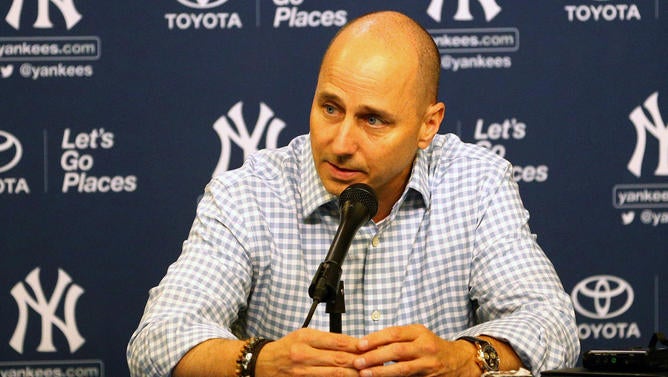
An important step! No owner wants to admit their team is not a serious contender and needs to take a step back before it can take a step forward. The Yankees did not trade Robinson Cano and David Robertson prior to their free agencies in recent years for this year very reason. Those were lost opportunities.
Owner Hal Steinbrenner reportedly was on the fence about trading veterans until right before the deadline. The Yankees were hovering around .500 when they were swept in a three-game series at last-place Tampa Bay in late July.
"A true playoff contender, not a playoff pretender, wouldn't do that," said general manager and perpetually candid Brian Cashman at the time.
Cashman admitted he was ready to sell for weeks prior to the deadline, but ownership wanted to see whether the Yankees climbed back into the race. It took that sweep to convince Steinbrenner and other members of ownership to sell. This is an important first step. It's not an easy thing to admit.
Step Two: Trade veterans for prospects

This is often the most painful and recognizable part of a rebuild, and the Yankees are in this process right now. Aside from dealing Chapman, Miller, Beltran, Nova and McCann, Brett Gardner and Chase Headley reportedly are on the market and could be next. I'm sure the Yankees would love to move Jacoby Ellsbury, but that seem unlikely given his contract.
Dealing Gardner and Headley is one thing. The real tests of the club's commitment to this youth movement are Masahiro Tanaka and Dellin Betances. Are the Yankees willing to make their ace and star homegrown reliever available? Both undoubtedly would bring quality prospects. Trading them also would signify the Yankees have no real plans to contend in 2017.
You easily could argue trading Tanaka and Betances would be wise. Tanaka is excellent and he just turned 28, but he can opt out of his contract after next season. The Yankees could be faced with losing him for nothing but a draft pick. Betances, as dominant as he is, has gotten a little worse with each passing season. His trade value may never be higher.
Point is, the Yankees not only have started trading away veterans, they're nearly done with it. There's not much beyond Gardner, Headley, Tanaka and Betances. Ellsbury might be immovable and others, like Tyler Clippard and Adam Warren, aren't going to fetch huge returns. The most valuable trade chips have been cashed.
Step Three: Incorporate young players into the roster
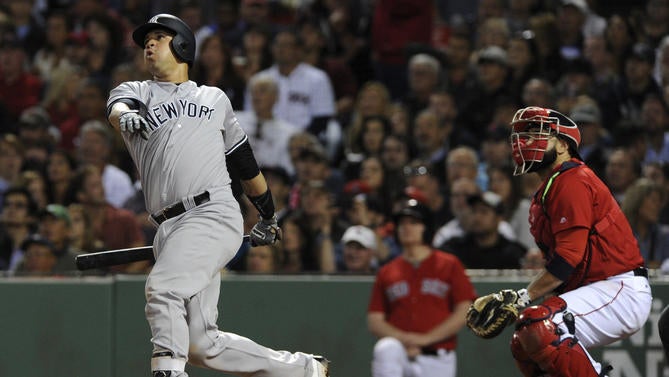
Step two and three have been happening concurrently. In fact, incorporating youngsters is something the Yankees started doing last year during the 2015 season. They called up Greg Bird and Luis Severino in the second half and gave them prominent roles. This trend continued in 2016 when Gary Sanchez, Aaron Judge, and Tyler Austin were thrown into the lineup in the second half.
The Yankees are in a unique position because so many of their best prospects are MLB-ready or close. Bird, Severino, Sanchez, Judge and Austin are in the big leagues (technically). Clint Frazier, the headliner in the Miller trade, finished 2016 in Triple-A. Others, like pitching prospects Jordan Montgomery and Chance Adams, will open 2017 in Triple-A. They don't have to wait for many of these guys
Of course, counting on young players can be risky. Severino had an electric debut in 2015 (2.89 ERA in 62 1/3 innings) before struggling mightily in 2016 (5.83 ERA in 71 innings). The Yankees are trying to figure out if he's a starter or reliever. Bird missed the entire 2016 season following shoulder surgery. Judge struck out in 44.2 percent of his plate appearances in his limited big-league time.
The Yankees hope Bird will be fine long-term -- he's completed his rehab and has played in the Arizona Fall League the last few weeks, which is good news -- and that Severino and Judge are only going through growing pains. This is part of the rebuilding process though. Not every young player reaches the show and dominates right away like Sanchez, the AL Rookie of the Year runner-up.
Incorporating young players is a long process that never really stops. Next year the Yankees want players like Frazier, Montgomery and Adams to get their feet wet in MLB. The year after that it'll be Gleyber Torres, the headliner in the Chapman trade, as well as 2015 first rounder James Kaprielian and third baseman Miguel Andujar. Acquiring prospects is easy. Turning them into big leaguers is where it gets tricky.
Step Four: Get under the luxury tax threshold
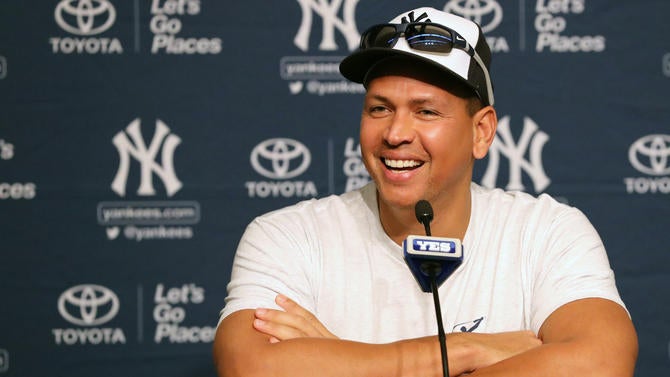
The Yankees have been over the luxury tax threshold ever since the system was put in place in 2002. Once the bill for the 2016 season comes in, the team will have paid more than $300 million in luxury tax over the years. No other team has come anywhere close to paying that much into the system.
Steinbrenner has stated his goal is to get the team's payroll under the luxury tax threshold at some point. Right now, the Yankees are taxed at 50 percent on every dollar over $189 million. Getting under the threshold would save the team luxury tax money in that given year, and also reset their tax rate. First time offenders are taxed at 17.5 percent, and that goes up each subsequent year.
The complicating factor here is the upcoming collective bargaining agreement. The current CBA expires on December 1 and MLB and the MLBPA are hard at work hammering out a new deal. The new CBA figures to change the luxury tax system in some way. At the very least, the luxury tax threshold will rise. It's set at $189 million right now. It might be over $200 million for 2017.
New York's best chance to get under the threshold is in two years, the 2018 season. By then most of the team's huge contracts will be off the books, including Alex Rodriguez -- yes, they still have to pay him in 2017 even after releasing him -- and CC Sabathia. Tanaka may opt-out as well. Gardner and/or Headley could be traded too. And don't forget the McCann trade frees up $11.5 million in both 2017 and 2018.
Once the Yankees get under the luxury tax threshold, whatever that number may be, the team is going to have much more financial flexibility. Most of the big contracts will be gone, payroll will be down, and the luxury tax rate will be reset. Also, the current CBA entitles the team to revenue sharing rebates by getting under the threshold as well. The Yankees are setting themselves up to be in a much better place financially.
Step Five: Spend, baby

Within two years, the Yankees want to have a core of young players and the financial flexibility to add big pieces. That's the master plan. This offseason's free-agent class is not very good, but we're two years away from Manny Machado and Bryce Harper becoming free agents. Nolan Arenado hits free agency the offseason after that. And then there's Shohei Otani. There are some big names due to hit the market down the line.
Of course, planning to sign free agents two or three years down the line is ridiculous and unrealistic. Those guys could sign extensions, their game could deteriorate, who knows? The Yankees are not planning to sign specific players, or at least they shouldn't be. They just want to put themselves in position to take advantage of the market when the time comes, like the Cubs did when they signed Jon Lester two offseasons ago and Jason Heyward, Ben Zobrist, and John Lackey last offseason.
The Yankees built their late-1990s dynasty around a historically great homegrown core -- we might never see a farm system produce two Hall of Famers (Derek Jeter, Mariano Rivera) and two borderline Hall of Famers (Andy Pettitte, Jorge Posada) in the span of two years again -- and supplemented it through free agency and trades. That's essentially the plan now. Grow a core, then add pieces from the outside.
This, of course, is much easier said than done. Theo Epstein and the Cubs made it look easy, but they'll be the first ones to tell you there's a lot of luck involved. Prospects don't always work out and that's why you need as many as possible. The Yankees have added 14 new ones in the last four months. Think about that. That's nearly half one of those top 30 prospect lists you see floating around the internet.
Times are changing around baseball. The Cubs are World Series champions and the Yankees are trading veterans for prospects. Everything we've known the last, well, century or so has been flipped upside down. Will New York's rebuild lead to their 28th World Series title? That's the goal, but getting there is a long process that includes many steps.










